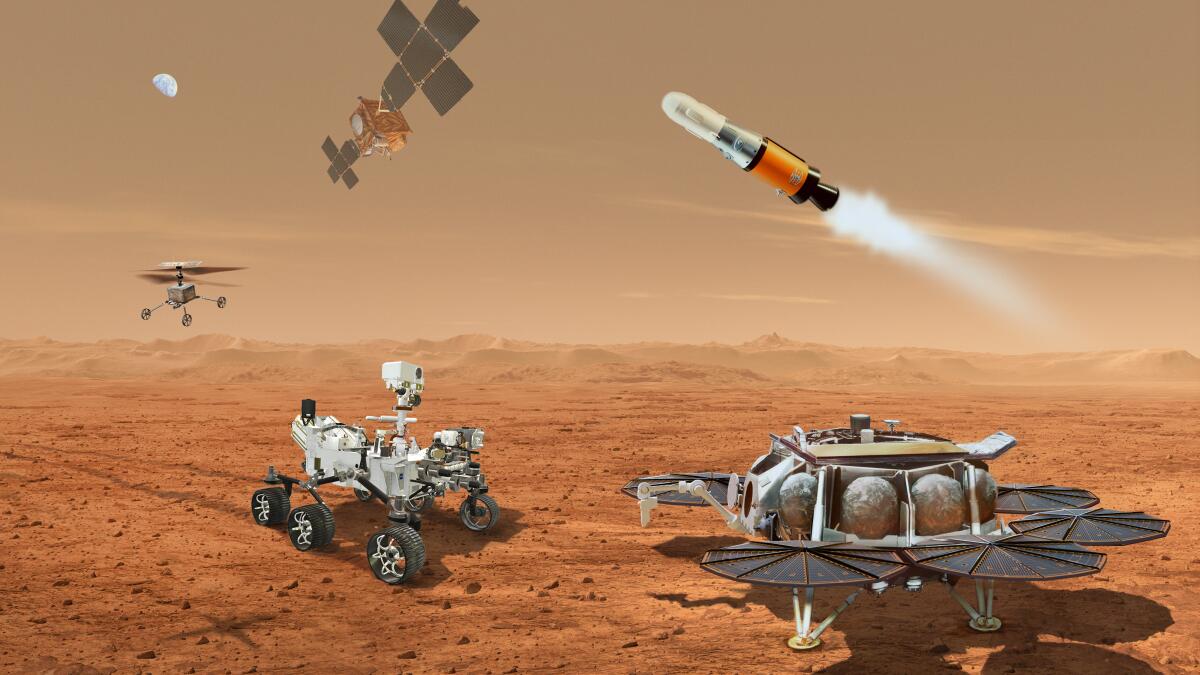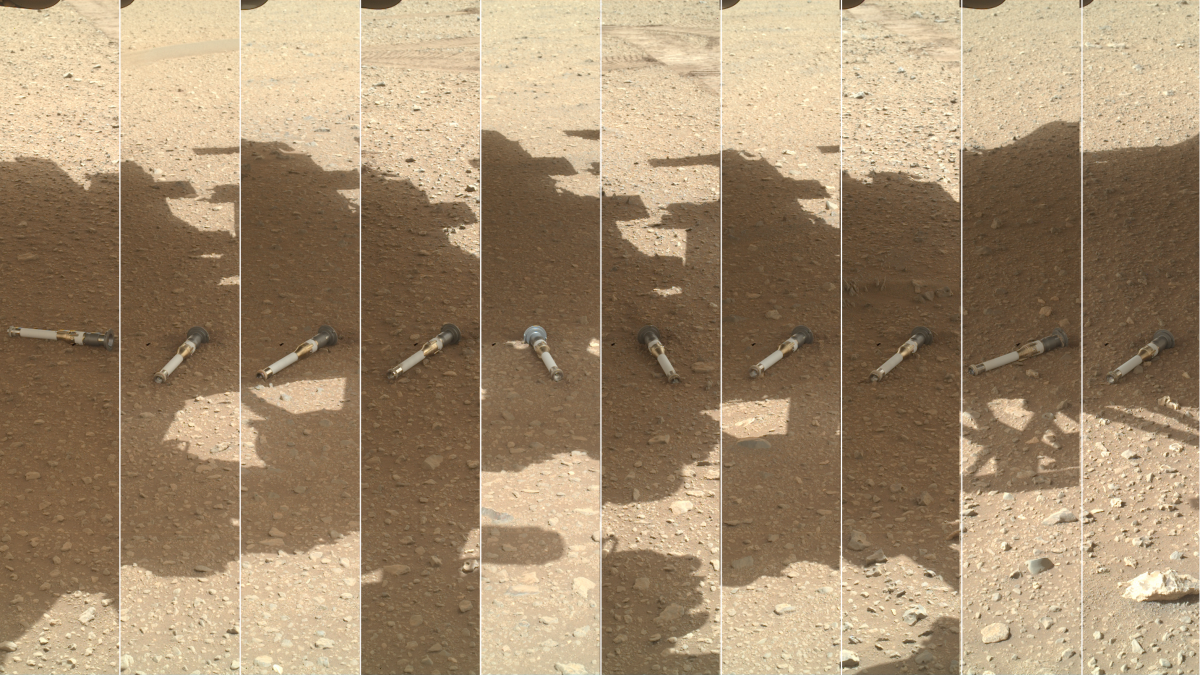NASA’s attempt to bring home part of Mars is unprecedented. The mission’s problems are not

- Share via
Massive cost overruns. Key deadlines slipping out of reach. Problems of unprecedented complexity, and a generation’s worth of scientific progress contingent upon solving them.
That’s the current state of Mars Sample Return, the ambitious yet imperiled NASA mission whose rapidly ballooning budget has cost jobs at NASA’s Jet Propulsion Laboratory in La Cañada Flintridge and drawn threats of cancellation from lawmakers.
But not all that long ago, those same dire circumstances described the James Webb Space Telescope, the pioneering infrared scope that launched on Christmas Day 2021.
The biggest space telescope ever has so far proved to be a scientific and public relations victory for NASA. The telescope’s performance has surpassed all expectations, senior project scientist Jane Rigby said at a meeting recently.
Its first images were so hotly anticipated that the White House scooped NASA’s announcement, releasing a dazzling view of thousands of galaxies the day before the space agency shared the first batch of pictures. Thousands of researchers have since applied for observation time.
“The world has been rooting for this telescope to succeed,” Rigby told the National Academies’ committee on astronomy and astrophysics.
Late last year, a spacecraft containing samples of a 4.6-billion-year-old asteroid landed safely in the desert after a 1.2-billion mile journey.
Yet in the years before launch, the success and acclaim Webb now enjoys were far from guaranteed.
The telescope cost twice as much as initially anticipated and launched seven years behind its original schedule. Some members of Congress at one point tried to pull funding from the project. Even the journal Nature referred to it at the time as the “telescope that ate astronomy.”
After a thorough assessment of the project’s needs and flaws, NASA was able to turn the troubled venture around. Supporters of Mars Sample Return are hopeful that mission will follow a similar trajectory.
“A lot of great science will come out of” Mars Sample Return, said Garth Illingworth, an astronomer emeritus at UC Santa Cruz and former deputy director of the project that is now the James Webb Space Telescope. “But they’ve got to get real as to how to manage this.”
Last year was a crisis point for Mars Sample Return, whose goal is to fetch rocks from the Red Planet’s Jezero crater and bring them back to Earth for study.
In July, the U.S. Senate presented NASA with an ultimatum in its proposed budget: Either present a plan for completing the mission within the $5.3 billion budgeted, or risk cancellation. A sobering independent review found in September that there was “near zero probability” of Mars Sample Return making its proposed 2028 launch date, and “no credible” way to fulfill the mission within its current budget. NASA is due to respond to that report this month.

The James Webb Space Telescope was further along in its development journey when it reached a similar crossroads in 2010, six years after construction began. Frustrated with the ballooning budget and constantly postponed launch date, the U.S. House of Representatives included no funding for the telescope in its proposed budget, which would have ended the project had the Senate agreed.
In a statement, lawmakers castigated the mission as “billions of dollars over budget and plagued by poor management,” foreshadowing the criticisms that would be leveled at Mars Sample Return more than a decade later.
To forestall cancellation, Sen. Barbara Mikulski (D-Md.) ordered an independent review of the project, which was under construction in her state.
The board determined that Webb’s problems stemmed from a “badly flawed” initial budget. All the technical expertise needed to complete this ambitious project was there, the evaluators concluded. But getting it done with the amount of money currently set aside would be virtually impossible.
Illingworth remembered that review when he read the Mars Sample Return assessment, which offered a similarly stark conclusion.
“Some of the words are very familiar,” he said with a chuckle.
When the Mikulski review came out in 2010, Illingworth was deputy director of the Space Telescope Science Institute, which now leads science and operations for the James Webb Space Telescope.

He was sympathetic to the challenges facing Mars Sample Return managers, though chagrined that the James Webb Space Telescope’s hard-earned lessons have apparently faded so quickly — especially the importance of having a realistic budget from the beginning.
NASA missions are managed by very smart people with established histories of doing very hard things. How does something as terrestrially mundane as budgeting continually trip them up?
“The problem is that the models that you have as a cost estimator — and they have very complex proprietary software models that attempt to understand these types of things — are all built on things that have happened, in the past tense,” said Casey Dreier, chief of space policy for the Planetary Society.
“By definition, when you’re trying something completely new, it’s very hard to estimate in advance how much something unprecedented will cost,” Dreier said. “That happened for Apollo, that happened for the space shuttle, it happened for James Webb, and it’s happening now for Mars Sample Return.”
Mars Sample Return also has some mission-specific challenges that Webb didn’t have to contend with. For one, it’s happening at the same time as Artemis, NASA’s wildly expensive mission to return people to the moon.
Expected to cost $93 billion through 2025, Artemis got a 27% increase in its budget over the previous year, while Mars Sample Return’s guaranteed funding is 63% less than last year’s spend.
And while NASA’s ambitions are growing, its funding from Congress, adjusted for inflation, has been essentially flat for decades. That leaves little room for unexpected extras.
“We are tasking the space agency with the most ambitious slate of programs in space since the Apollo era, but instead of Apollo-era budgets, it has one-third of 1% of U.S. spending to work with,” Dreier said. “If you stumble right now, the wolves will come for you. And that’s what is happening to Mars Sample Return.”
With a final 2024 budget for NASA in place, the space agency has directed JPL not to cut any more staff working on the Mars Sample Return mission.
Not all ambitious scientific endeavors survive the kind of scrutiny the sample return is facing. In 1993 Congress canceled the U.S. Department of Energy’s Superconducting Super Collider, an underground particle accelerator, citing concerns about rising costs and fiscal mismanagement. The government had already spent $2 billion on the project and dug 14 miles of tunnel.
But in the same week that Congress ended the supercollider, it agreed — by a margin of a single vote — to continue funding the International Space Station, a similarly expensive project whose cost overruns had been widely criticized. ISS launched in November 1998 and is still going strong. (For now, anyway — NASA will intentionally crash it into the sea in 2030.)
The space station’s future was never seriously threatened again after that painfully close vote, just as Webb’s future was never seriously questioned after the 2010 cancellation threat.
JPL, the institution managing Mars Sample Return, has already paid dearly for the mission’s initial stumbles, laying off more than 600 employees and 40 contractors after NASA ordered it to reduce its spending.
But projects that survive this kind of reckoning often emerge “stronger and more resilient,” Dreier said. “They know the eyes of the nation and NASA and Congress are on them, so you have to perform.”
NASA is set to reveal this month how it plans to move forward with Mars Sample Return. Those familiar with the mission say they believe it can still happen — and that it’s still worth doing.
“Do I have faith in NASA, JPL, all of those involved to be able to deliver on the Mars Sample Return mission with the attention and technical integrity that it requires? Absolutely,” said Orlando Figueroa, chair of the the mission’s independent review team and NASA’s former “Mars Czar.”
“It will require very difficult decisions and levels of commitment, including from Congress, NASA and the administration, [and] a recognition of the importance, just like was the case with James Webb, for what this mission means for space science.”
Scientists have created a synthetic molecule that appears capable of attacking a broad range of bacteria that have become dangerously resistant to workhorse medicines.










